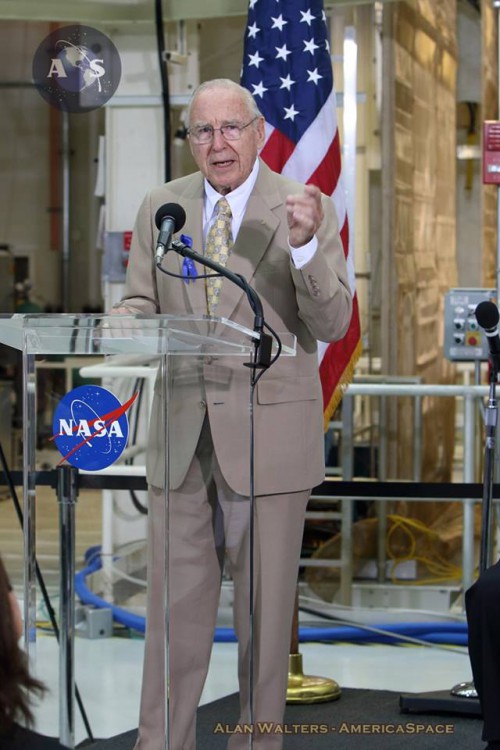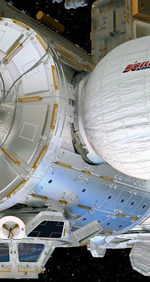
Navy Capt. James A. Lovell Jr. (ret), the first astronaut to fly two trips to the Moon while also leading the Apollo 13 crew’s successful fight for survival, is calling for a return to the Moon as the key element in U.S. preparations for human missions to Mars.
In an exclusive interview with AmericaSpace at the Smithsonian National Air & Space Museum, where he was awarded the Museum’s Lifetime Achievement award Apr. 5, Lovell said, “My real wish is that we develop the technology to go back to the Moon to really study and get comfortable in living on and exploring the Moon, to use THAT technology as the basic infrastructure we will use on the initial human flights to the surface of Mars.”
He declined to discuss the Asteroid Retrieval Project (ARM) mandated by President Barack Obama, telling AmericaSpace he instead believes the lunar route “will be a quicker, more effective way” of preparing for Mars missions than retrieving a boulder off an asteroid for astronauts to visit in lunar orbit.

“I think the space program over the last 40 years in the 20th Century was really a great boost to this country, and I am sorry to see it now slow down,” Lovell told AmericaSpace.
He commented favorably, however, on current media coverage of the space program compared with space coverage in the 1960s-70s, where he said 80 percent of the media “went home after the first lunar landing by Apollo 11.”
“Now we have a lot of different websites that discuss in all manner of ways what we are doing now and planning in the future. They also air a lot of controversy,” said Lovell. “This tells me that there are a tremendous number of people that think that the county being involved in space technology and science is a good thing, because it really has a great effect on the prestige of the U.S. and how other people think of the U.S.”
On receiving the Smithsonian Air and Space Museum’s Lifetime Achievement Award, he told AmericaSpace: “This is quite a prestigious award. I looked up the previous recipients and found that I will be joining a very exclusive club. I’m getting up there in age now at 88, so this really caps my career.”
Lovell logged more than 7,000 flight hours with the Navy and more than 715 hours in space as a NASA astronaut.
“From childhood dreams of rockets, to the U.S. Naval Academy, flight training, service as a carrier based night fighter pilot, and test pilot school, Lovell rose to his greatest heights as an astronaut,” said the Smithsonian’s awards citation.
Selected by NASA in 1962 with the second group of astronauts, he flew four historic missions:
- Gemini VII in 1965 with Frank Borman in orbit for nearly 14 days.
- Gemini XII in 1966 where copilot Buzz Aldrin proved out critical skills for EVA (extravehicular activity).
- Apollo 8 in 1968 the first manned flight to orbit the Moon.
- And Apollo 13 in April, 1970 the planned third lunar landing that turned into a self rescue mission when a Service Module cryogenic oxygen tank exploded turning the Grumman Lunar Module “Aquarius” into a lifeboat for for the safe return to Earth of Lovell, Fred Haise and the late Jack Swigert for a landing in the South Pacific in the Command Module “Odyssey.”
Since retiring from NASA in 1972, “he has advocated passionately for the future of space exploration,” the Museum said.
Lovell said “Apollo 8 was unequivocally the high point of my life, being the navigator on that first 240,000 mile trip to the Moon.” He told about 300 invited guests that he hopes to go to heaven when he dies, but that after Apollo 8, “I know we really go to heaven when we are born—on a planet with life giving resources orbiting a star that provides energy for life.”
He said, “Apollo 13 may have been the best thing to happen to NASA because it showed the agency was growing complacent as the rest of the country as a whole was growing complacent.” But Mission Control turned an almost certain catastrophe into a great triumph.
The Museum’s Current Achievement Award was presented to the New Horizons spacecraft team headed by Alan Stern at the same glittering black tie dinner that honored Lovell.
“The winners of the 2016 Trophy Awards have significantly advanced space exploration in major ways,” said retired Marine Gen. J.R. “Jack” Dailey, Director of the Museum. “They have demonstrated the courage, tenacity and innovative spirit that defines leaders in America’s space program from its early years through today.”
“We are proud to have run the anchor leg of 50 years of U. S. planetary exploration,” said Stern, principal investigator of the New Horizons mission. “We have opened a new beginning of planetary exploration and we have shown how much the public craves new exploration.”

Established in 1985, the Lifetime and Current Achievement awards recognizes outstanding achievements in the fields of aerospace science and technology and their history. As in past years, trophy winners receive a miniature version of “The Web of Space,” a sculpture by artist John Safer.
The New Horizons award marked the second year in a row that the Johns Hopkin’s Applied Physics Laboratory was honored by the Smithsonian. In 2015 it presented the Lifetime Achievement award to APL’s Dr. Tom Krimigis, who led the development of instruments launched to every planet in the Solar System, including Pluto on the New Horizons spacecraft.
The New Horizons mission team accomplished the first direct reconnaissance of Kuiper Belt objects in the outer Solar System. “The scientific return from the flyby of the Pluto-Charon system has already been spectacular,” said the Museum’s citation.
“The wide diversity of terrains and the young ages of some of them are causing scientists to rethink how planets form and evolve,” says the Smithsonian citation.
New Horizons imaged water-ice mountains as high as the Rockies, giant sheets of exotic ices that exhibit glacier like flow, and chasms deeper and wider than the Grand Canyon.
In addition to this reporter, who has been on the Air and Space Museum’s awards selection board for 31 years, other selection committee members include Wayne Hale, retired shuttle Program Manager and Flight Director; retired astronaut Dr. Kathryn D. Sullivan, now NOAA Administrator; retired astronaut and shuttle commander Pamela Melroy; Dr. John C. Mather, winner of the 2006 Nobel Prize in Physics and Senior Project Scientist for the Webb Space Telescope; Russian space historian Asif A. Siddiqi, of Fordham University; Wesley T. Huntress of the Carnegie Institution; and “Miracle on the Hudson” retired U.S. Airways Captain Chesley B. Sullenberger III, of Safety Reliability Methods, Inc.
.
Be sure to “Like” AmericaSpace on Facebook and follow us on Twitter: @AmericaSpace
.





The NATION’S Aerospace INDUSTRY will soon be RETURNING to Luna.
A very interesting article. Lovell is quite correct in that we must return to the moon to develop the prerequisite technologies for a Mars mission. (Let’s not be upstaged by the Chinese!) It would be a tribute to the Apollo pioneers to announce a commitment for a return to the moon.
“develop the technology to go back to the Moon to really study and get comfortable in living on and exploring the Moon”
Yep, and Congress wants to use taxpayer money to put NASA astronauts on the Moon.
Google: PUBLIC LAW 111–267—OCT. 11, 2010
A Lunar ISRU base could be very useful.
Yes, the Lunar ISRU is a major part of the equation.